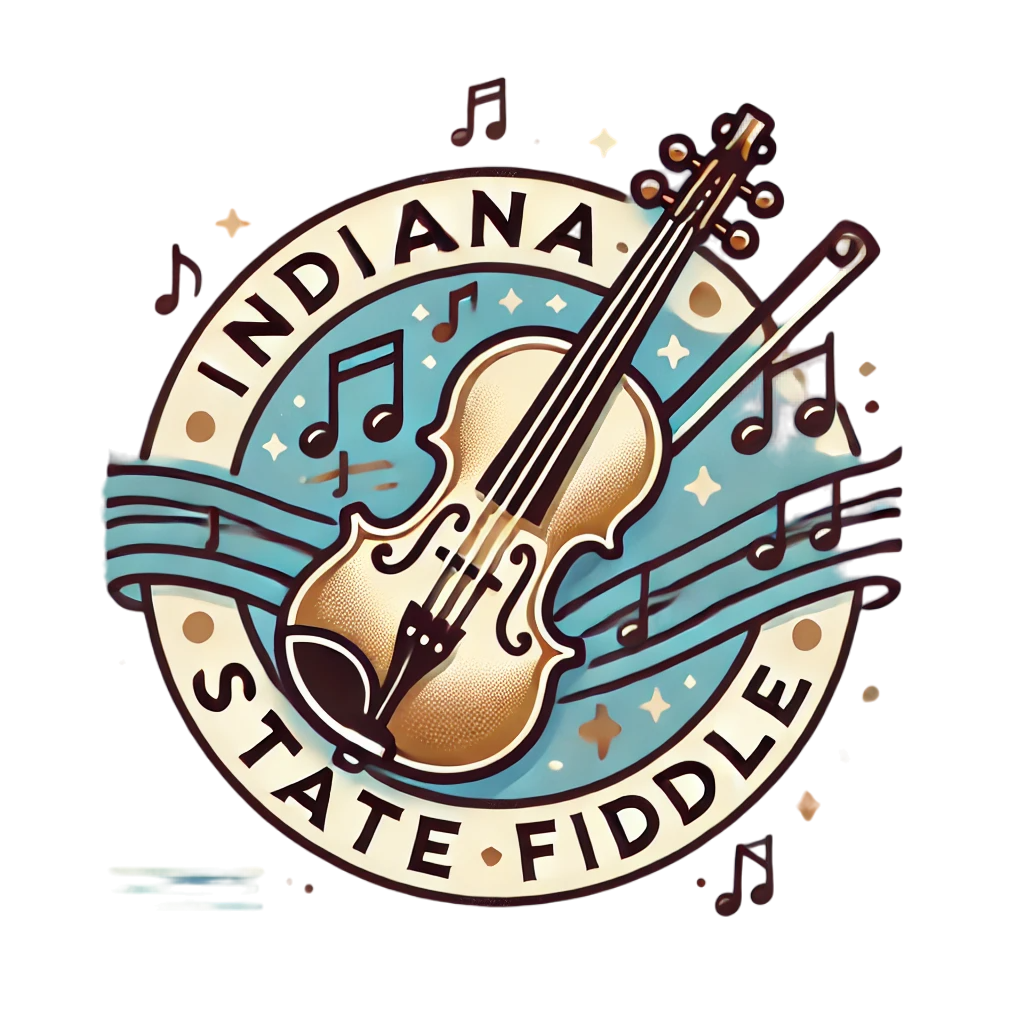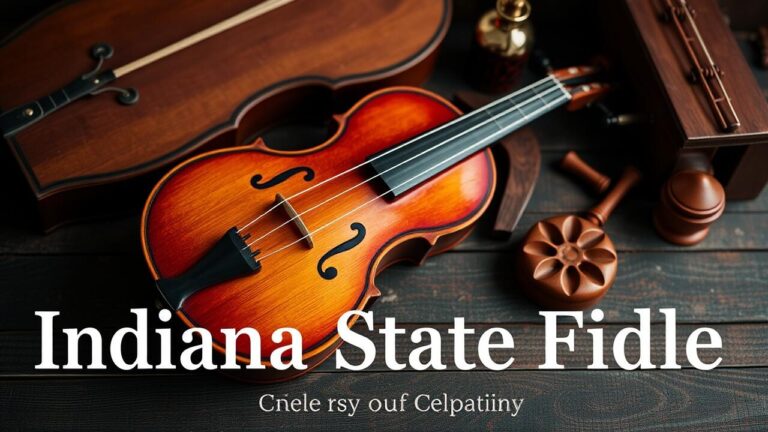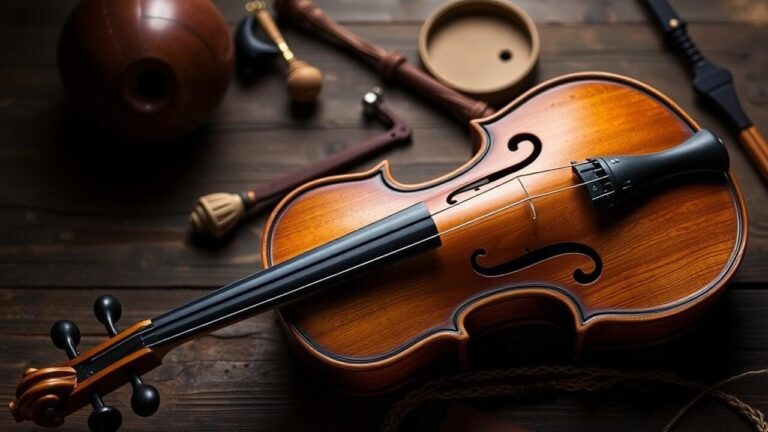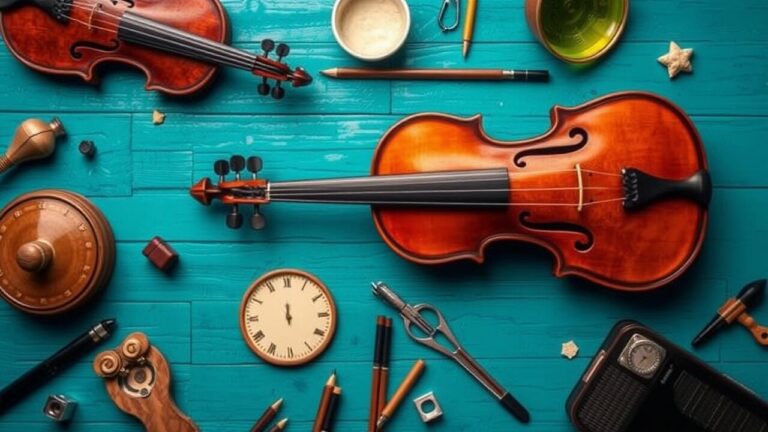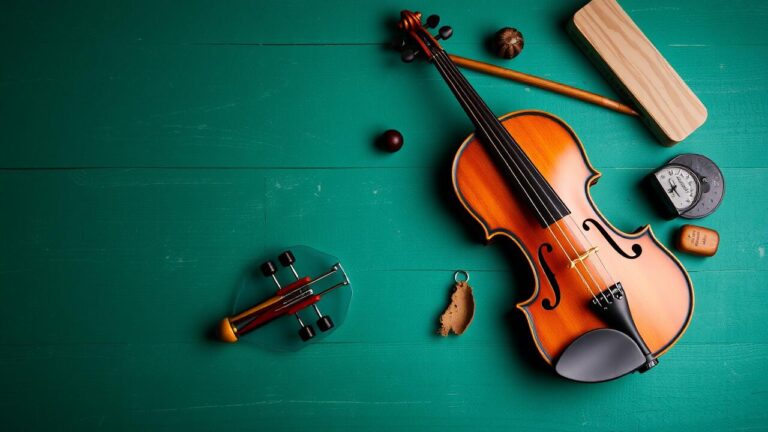How to play the Indiana State Fiddle
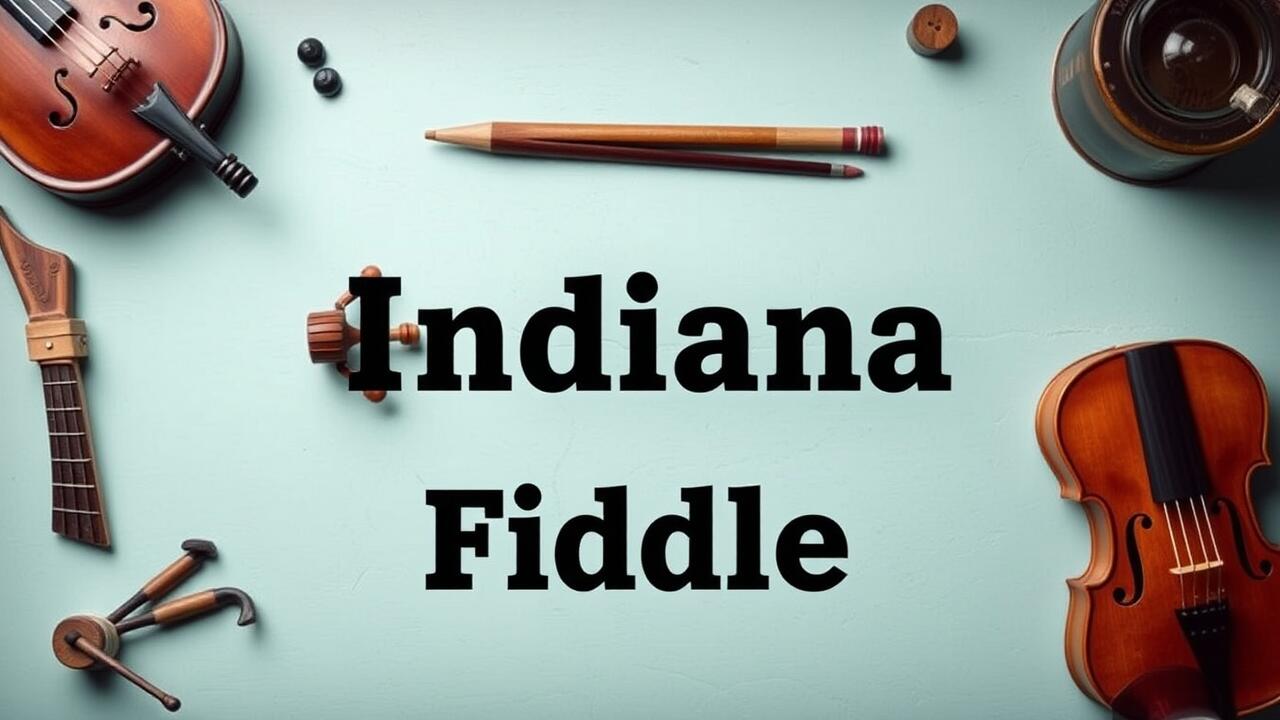
Table Of Contents
Learn How to Play the Indiana State Fiddle with Easy Steps
How To Play The Indiana State Fiddle | Understanding the Indiana State Fiddle
Understanding the historical significance of the Indiana State Fiddle is crucial for anyone eager to learn how to play the Indiana State Fiddle. Rooted in the rich tradition of American fiddle music, Indiana’s fiddling style showcases a vibrant tapestry of cultural influences. Fiddle playing in this region has been shaped by its diverse population and hosts events like the National Fiddle Contest, celebrating talented fiddlers across the country. Indiana University plays an essential role in promoting this musical heritage, offering valuable resources and education for aspiring musicians. By appreciating these elements, players can deepen their connection to the music and enhance their fiddle experience.
How to play the Indiana State Fiddle | Historical Significance of the Indiana State Fiddle
The Indiana State Fiddle holds a rich historical significance, particularly in the context of old-time fiddle traditions. As a key element of folk music in the state, it reflects the vibrant cultural tapestry of northern Indiana and northwestern Indiana. Fiddlers would gather at battle grounds of music and storytelling, shaping a unique sound that has become synonymous with the region. Learning how to play the Indiana State Fiddle not only connects musicians with the past but also helps preserve these lasting traditions.
The Indiana State Fair has long been a celebration of fiddling, where both seasoned players and novices showcase their skills. Events often feature competitions and performances that highlight the importance of the fiddle in Indiana’s cultural identity. For those looking to master how to play the Indiana State Fiddle, embracing its historical roots and regional significance enhances the learning experience, providing a deeper appreciation for this cherished instrument.
Characteristics of the Indiana State Fiddle
The Indiana State Fiddle is known for its unique blend of fiddle styles that have evolved through the state’s rich musical heritage. Many old time fiddlers from places like Newburgh and Orange County have contributed to this distinctive sound. Competitions, such as the National Old Time Fiddlers Contest held in Wisconsin, highlight the intricate techniques and lively rhythms that characterize the playing of the Indiana State Fiddle. Understanding how to play the Indiana State Fiddle involves embracing these various styles, which reflect both regional influences and traditional folk music.
A typical Indiana State Fiddle exhibits craftsmanship that allows for a bright, resonant tone. This quality is essential for executing the fast-paced tunes often associated with old time fiddling. The use of specific materials and construction techniques distinguishes Indiana fiddles from others, making them particularly suited for a variety of genres. Mastery of how to play the Indiana State Fiddle requires attention to these characteristics, enabling players to express the rich cultural narratives embedded in the music of Indiana.
Essential Equipment for Playing
Understanding the essential equipment is crucial for mastering how to play the Indiana State Fiddle. Selecting the right fiddle is the foundation; it should resonate well with the musician and suit their playing style. Nearby states like Missouri and Arkansas have rich fiddling traditions, influencing the styles and types of violins available. Accessories such as rosin, a quality bow, and a chin rest enhance playability and comfort. Maintenance equipment is also important, as preserving the instrument’s integrity impacts performance longevity. Musicians familiar with fretted instruments like guitars or mandolins might find similarities in technique, while those from Kansas or Nebraska can draw inspiration from regional fiddling styles, adding to their repertoire as they learn how to play the Indiana State Fiddle.
- High-quality fiddle with a rich tone
- Rosin for bow traction
- Durable bow that complements the fiddle
- Comfortable chin rest and shoulder pad
- Cleaning cloth to maintain the instrument’s finish
- Case for safe transport and storage
- Tuner to ensure proper pitch and tuning
Choosing the Right Fiddle
Selecting the perfect fiddle is essential for anyone eager to learn how to play the Indiana State Fiddle. Consider trying out instruments from various regions, including styles influenced by traditional sounds from Tennessee, Ohio, and Illinois. The unique qualities of fiddles made in these states can significantly impact the tone produced while playing. Enthusiasts in cities like Indianapolis and Bloomington often appreciate the craftsmanship of local luthiers.
Quality and comfort should guide your choice of fiddle. It’s important to find one that suits your playing style and physical build, whether you’re transitioning from another string instrument such as a banjo, mandolin, or even those drawn from Minnesota’s folk traditions. Testing different fiddles can make a noticeable difference, helping you to master how to play the Indiana State Fiddle with the right instrument in hand.
Necessary Accessories and Maintenance
Essential accessories enhance the experience of fiddling and ensure proper maintenance of the instrument. Rosin is crucial for creating the right friction on the bow, allowing for smooth sound production as you play tunes from the Ohio River region or traditional Iowa reels. A quality shoulder rest provides comfort and stability while holding the fiddle, making it easier to focus on the melody. Investing in a sturdy case protects your fiddle from damage, ensuring that all your accessories, including your playlist of favorite songs, are easily accessible for practice sessions.
Regular maintenance is vital to keep your Indiana State Fiddle in top shape. Wiping down the strings and body after each use helps prevent buildup of rosin and dirt, preserving the instrument’s sound quality. Checking the bridge and sound post for proper alignment is essential to ensure optimal acoustics. Learning how to play the Indiana State Fiddle involves not just mastering techniques but also understanding how to care for the instrument, allowing you to explore different styles and continues to enjoy fiddling for years to come.
Basic Techniques for Beginners
Understanding the foundational techniques is essential for anyone eager to learn how to play the Indiana State Fiddle. Beginners should focus on the proper way to hold the fiddle, allowing for a comfortable grip that facilitates movement and stability. Mastering bowing techniques is equally important, as it sets the stage for producing the smooth, rhythmic sound characteristic of midwestern fiddling styles. Hoosiers have a rich tradition in swing music and various fiddle tunes, making it vital for aspiring Indiana fiddlers to practice these basics early on. By learning how to play the Indiana State Fiddle correctly, players can connect with the cultural heritage of the region while developing their unique sound.
Holding the Fiddle Properly
Proper posture is essential for any aspiring Indiana fiddler. Position the fiddle close to your chin, ensuring that it rests securely on your shoulder. Your left hand should curve around the neck of the fiddle, with your fingers poised to press down on the strings. A strong grip is not necessary; a relaxed hand allows for more fluid movement as you learn how to play the Indiana State Fiddle. Observing experienced midwestern fiddlers can provide insight into effective techniques and comfort levels needed for optimal positioning.
The bow holds great importance in achieving a beautiful sound. Grip the bow near the frog, allowing the fingers to wrap naturally around it. Your wrist should remain flexible, enabling smooth strokes across the strings. A common mistake among beginners is tensing the arm, which can hinder performance and cause fatigue. Watching accomplished Indianapolis fiddlers demonstrate their technique can serve as invaluable inspiration. Pay close attention to their bowing movements while considering the best practices of good midwestern fiddlers.
Bowing Techniques
Mastering bowing techniques is essential for anyone learning how to play the Indiana State Fiddle. This unique style reflects a rich history rooted in early Indiana traditions and is characterized by a distinct sound that distinguishes a midwestern style fiddler. Techniques such as legato and staccato contribute to the expressive play of twin fiddle arrangements, allowing fiddlers to perform beautifully alongside second fiddles. Understanding how to create smooth bow strokes will enhance your overall performance and connect you with the vibrant world of traditional arts Indiana.
Practicing various bowing styles can significantly improve your skill set as you learn how to play the Indiana State Fiddle. Fiddlers often employ a mix of short and long bow strokes to create varying dynamics and textures. Engaging with resources from midwest_fiddler can provide insights into the nuances of bowing, helping you to develop a personal style. Experimenting with different bowing techniques will not only sharpen your dexterity but also deepen your appreciation for the cultural significance of indiana state picking in the fiddle community.
| Bowing Technique | Description | Application |
|---|---|---|
| Legato | A smooth and connected bow stroke that produces a flowing sound. | Used in melodies to create a lyrical and expressive feel. |
| Staccato | A detached and abrupt bow stroke that creates a short, crisp sound. | Commonly employed for rhythmic accents and lively passages. |
| Martelé | A sharp, bounced bow stroke that emphasizes individual notes. | Used for creating dynamic character and energetic impact in performances. |
| Sauté | A light and bouncy bow stroke that can create a playful sound. | Ideal for lively folk tunes and dances. |
Learning to Read Fiddle Music
Understanding musical notation is crucial for anyone looking to master how to play the Indiana State Fiddle. Good fiddlers often emphasize the importance of reading fiddle music accurately to perform traditional fiddle tunes effectively. Indiana University M.A. programs offer resources and workshops that delve into the intricacies of notation, helping students become proficient in interpreting scores. Fiddle clubs provide a supportive environment for practice and learning, where players can share techniques and discuss strategies for competitions like fiddle contests. Exploring the works of renowned Norwegian-American fiddlers can also inspire new interpretations and styles, enriching one’s repertoire as they learn to play.
Overview of Standard Musical Notation
Understanding standard musical notation is essential for anyone looking to learn how to play the Indiana State Fiddle. This notation serves as a universal language for musicians, outlining the pitch, rhythm, and dynamics of the music. A good fiddler will recognize the symbols that indicate the notes and their values, enabling them to play music effectively. Many indiana folk songs and fiddle tunes are structured with this notation, making it easier to participate in local fiddler championships and jam sessions within the community.
Learning to interpret standard notation also provides a solid foundation for exploring various American fiddle styles, including Appalachian fiddle styles. Mastering these skills allows aspiring fiddlers to connect with the rich musical tradition of North America. Understanding how to read notation not only enhances a fiddler’s ability to perform but also offers greater insight into the nuances of playing different genres and the historical context behind each piece.
- Familiarize yourself with different note types (whole, half, quarter, and eighth notes).
- Learn about their corresponding rest symbols that indicate silences in music.
- Practice recognizing the staff and the clefs used in standard notation, primarily the treble clef for fiddle music.
- Understand key signatures and how they affect the scale and tonality of a piece.
- Get accustomed to time signatures that dictate the meter of a piece, such as 4/4 or 3/4.
- Explore dynamic markings that indicate the volume and intensity of the music.
- Regularly read and play various folk tunes to enhance note recognition and performance skills.
Understanding Fiddle Tablature
Fiddle tablature serves as a user-friendly guide for those looking to learn how to play the Indiana State Fiddle. This notation system displays the placement of fingers on the strings rather than traditional musical notes. Many mid-west fiddlers, including southern-born fiddlers, often prefer tablature for its simplicity, making it easier to follow along during fiddle events. By using this format, aspiring fiddlers can quickly learn to play their favorite fiddle songs even if they are new to reading standard notation.
As Indiana natives explore the intricacies of fiddle music, understanding tablature becomes essential. Various fiddle songs can be transcribed into this format, allowing beginners to start playin right away. Familiarizing oneself with the structure of tablature can help players connect with their favorite fiddlers and enhance their skills. This method is especially popular among those who appreciate the vibrant culture of the Indiana State Fiddle, where hot fiddle styles and lively performances abound.
Practicing Scales and Exercises
Mastering scales and exercises is essential for anyone learning how to play the Indiana State Fiddle. Great fiddlers often emphasize the importance of practicing scales to build a solid foundation. Old time fiddlers frequently incorporate these exercises into their warm-up routines, helping them prepare for fiddle contests and performances. A good fiddle teacher can guide students through the various scales, ensuring a better understanding of fiddle music that exists in many forms. With a focus on original fiddle tunes, beginner players can also find free fiddle lessons online that highlight important techniques. Whether aiming to become a national fiddler champion or simply enjoying music, consistent practice is key to developing proficiency.
Major and Minor Scales
Mastering scales is foundational for anyone looking to learn how to play the Indiana State Fiddle. Major and minor scales serve as building blocks for understanding melodies and harmonies. Notable fiddlers, including both immigrant fiddlers and local Bloomington musicians, often showcase these scales in their performances. Fiddle contest rules frequently emphasize the importance of scale proficiency, making it essential for participants to hone their skills.
Practicing these scales not only enhances technical ability but also lays the groundwork for more complex techniques. Old time fiddlers and girl fiddlers alike utilize major and minor scales to express emotion and narrative through their music. Learning from seasoned artists, such as distinguished Indianapolis musicians or fine fiddlers, can provide invaluable insights into effectively incorporating these scales into your repertoire. Understanding how to play the Indiana State Fiddle becomes more rewarding with this essential knowledge.
Common Exercises for Dexterity
Practicing dexterity is essential for any aspiring fiddler. Many fiddlers, including renowned old-time fiddler Melvin Wine, have emphasized the importance of consistent finger exercises to enhance agility on the strings. These exercises not only help players develop finger strength but also improve familiarity with the instrument, which is vital for mastering how to play the Indiana State Fiddle. Engaging in regular practice of scales and simple melodies can lead to a more fluid playing style over time.
Exploring the nuances of fiddle playing often requires a grasp of various exercises that challenge coordination and rhythm. Metis fiddler John has shown how techniques borrowed from banjo playing can be applied to the fiddle, creating unique sounds and styles. Indiana history books highlight these cultural exchanges in music, showing the evolution of the fiddle within the community. Players looking to elevate their skills should prioritize exercises that focus on finger independence and bow control, ensuring a solid foundation for advanced techniques.
Playing Traditional Indiana Fiddle Tunes
Learning how to play the Indiana State fiddle involves immersing oneself in the rich tapestry of traditional tunes that reflect the cultural heritage of the region. Various genres, such as old-time fiddlers and square dance fiddlers, showcase the diverse influences that shape the music. Mastery of different fiddle dialects adds depth to performances, while understanding the significance of playing harmonies enriches the overall sound. From lively hornpipes to classic tunes celebrated in southern Wisconsin, the repertoire of a fair fiddler offers endless opportunities for expression. Engaging with these traditional melodies not only teaches aspiring musicians how to play the Indiana State fiddle but also connects them to the community of fiddlers who keep this vibrant tradition alive.
| Tune Name | Genre | Region | Key Signature |
|---|---|---|---|
| Red River Valley | Old-Time | Midwest | D Major |
| Windy City Waltz | Waltz | Illinois | B Minor |
| John Brown’s Dream | Square Dance | Indiana | C Major |
| Arkansas Traveler | Old-Time | Southern USA | A Major |
Popular Songs and Their Origins
Traditional Indiana fiddle music boasts a rich tapestry of songs that originate from various cultural backgrounds. Many tunes reflect the influence of European immigrants who settled in Indiana, blending their musical traditions with local styles. Learning how to play the Indiana State Fiddle involves understanding these origins, as well as the playing characteristics that differentiate Indiana fiddle music from other genres. Skilled fiddlers often collaborate with accompaniment instruments such as guitars and mandolins, enhancing the overall sound and bringing historical context to the performance.
Qualified women fiddlers have played a significant role in popularizing these songs, showcasing their talent through various performances and community events. Resources like fiddle YouTubes offer valuable insights into learning specific tunes, while the Indiana calendar highlights upcoming festivals where musicians gather to share their craft. Aspiring fiddlers gain proficiency by exploring traditional songs and understanding their cultural significance. Studying mandolin basics can also complement fiddle playing, ensuring a well-rounded musical experience.
Resources for Learning New Tunes
Exploring how to play the Indiana State Fiddle is an exciting journey for musicians at any skill level. A great resource for learning new tunes is attending local fiddling events or workshops, especially in regions known for their musical heritage like northern Wisconsin. Participants can learn from seasoned players and share techniques, enhancing their understanding of midwestern fiddling traditions. Resources such as community centers or music schools often offer classes to get started, fostering a dynamic environment for budding fiddlers.
The rise of online platforms has revolutionized how players discover and share music. Videos and instructional materials, such as those focused on the imo clawhammer banjo or cigar-box fiddle techniques, provide diverse perspectives on playing styles. Websites dedicated to Carolina fiddling often include sheet music and performance tips, catering to those interested in various genres. By utilizing these resources, aspiring fiddlers can effectively broaden their repertoire and deepen their appreciation for the craft of how to play the Indiana State Fiddle.
Advanced Playing Techniques
Mastering advanced techniques on the Indiana State Fiddle can elevate a player’s performance significantly. Understanding how to play the Indiana State Fiddle with greater finesse includes exploring ornamentation and vibrato, which add emotional depth to tunes. Quick practice sessions focusing on these techniques will help musicians integrate them more seamlessly into their performances. Players can also benefit from engaging in twin fiddling, a style that fosters collaboration and spontaneity, commonly found in traditional bands. The influence of historical figures, like Connor McCracken and the legacy of slave musicians, can inspire modern players to experiment with diverse musical styles while honing their craft. Knowing how to play the Indiana State Fiddle means embracing both the technical aspects and the rich musical history it embodies.
Ornamentation and Vibrato
Mastering ornamentation is essential for adding depth and character to your tunes on the Indiana State Fiddle. Techniques such as trills, slides, and double stops enrich the sound and elevate your playing. By practicing these embellishments, you learn how to play the Indiana State Fiddle in a way that resonates with traditional styles. Repeating these techniques in various tunes allows for a natural incorporation into your overall performance.
Vibrato is another vital aspect of achieving a professional sound on the fiddle. This technique involves oscillating the pitch of a note slightly, creating warmth and expression. Understanding how to play the Indiana State Fiddle with effective vibrato will enhance the emotional impact of your music. Practicing vibrato consistently will help you master how to play the Indiana State Fiddle, making your tunes more engaging to listeners.
Exploring Different Styles
Diverse fiddle styles contribute to the rich tapestry of Indiana’s musical heritage. Regions like Orange County and Newburgh have fostered unique approaches to how to play the Indiana State Fiddle. Old-time fiddlers from Indiana often participate in events like the National Old Time Fiddlers Contest, showcasing their techniques and interpretations. These styles can vary significantly, influenced by the cultural backgrounds and traditions of the players.
Exploring fiddle styles is essential for any aspiring musician. Wisconsin’s old-time fiddlers, for example, bring different elements to the genre, blending them with Indiana’s unique sound. Understanding these variations can enhance a player’s repertoire and technique. Whether aiming to master classics or experiment with contemporary influences, knowing how to play the Indiana State Fiddle encompasses learning from these diverse traditions.
Conclusion
Learning how to play the Indiana State Fiddle opens doors to a rich musical tradition that celebrates folk heritage. Aspiring musicians can draw inspiration from renowned fiddlers, including those who participate in fiddle contests and fiddle clubs. The vibrant fiddle music scene often features performances that highlight popular fiddle tunes with diverse backgrounds. Many students pursue higher education, such as an Indiana University M.A., to deepen their understanding and skills. Norwegian-American fiddlers have also made significant contributions, showcasing unique styles that enhance the overall fiddle landscape. Engaging with fellow musicians and mentors will foster growth and creativity, leading to becoming good fiddlers in this cherished art form.
FAQS
How is fiddle music represented by proficient fiddlers in Indiana, Kentucky, and Wisconsin, and what can be learned about Missouri fiddling and old tyme fiddlers in this region?
Fiddle music exists as a rich tradition throughout North America, with proficient fiddlers in regions like Indiana, Kentucky, and Wisconsin showcasing unique styles. In Indiana, the influence of Missouri fiddling and the famous hornpipe fiddlers can be observed, while old tyme fiddlers continue to practice in areas such as Newburgh, Indiana, and Orange County. The culture of Indiana fiddling, along with notable musicians like Leonard from Wisconsin, contributes to a vibrant community of entering fiddle music enthusiasts. Furthermore, the battle ground of these musical traditions reflects the diversity and history encompassed by various forms of fiddle playing.
What unique elements define the performance style of proficient fiddlers from Orange County, Indiana, and how do they compare to Wisconsin fiddler Leonard and North America fiddlers like Melvin Wine?
Proficient fiddlers from Orange County, Indiana, often incorporate a blend of traditional and contemporary techniques, showcasing their unique cultural influences. This includes the use of harps and a distinctive battle ground style that resonates with local heritage. Comparatively, Wisconsin fiddler Leonard and other North America fiddlers like Melvin Wine bring their regional styles into the mix, often emphasizing community dance traditions and old-time fiddle music, which can also be seen in the popular medicine fiddle repertoire.
What influences the playing style of proficient fiddlers like Melvin Wine in Indiana and how does it relate to the battle ground of fiddlers in the region?
The playing style of proficient fiddlers in Indiana, such as Melvin Wine, is heavily influenced by the historical and cultural backdrop of the region which has seen a variety of musical traditions. The battle ground for these fiddlers lies in their ability to blend different styles, creating a unique approach that reflects both personal flair and regional characteristics. Fiddlers in this area often share techniques and evolve their sound through community engagement, showcasing a rich heritage of fiddling that resonates with their audiences.
What is the significance of the battle ground for proficient fiddlers in Indiana, and how does it relate to the styles of famous fiddlers like Melvin Wine?
The battle ground for proficient fiddlers in Indiana highlights the competition and camaraderie among fiddlers, showcasing their unique techniques and styles. Fiddlers like Melvin Wine represent a rich tradition of fiddling in Indiana, where the way fiddlers approach their craft has evolved through both competition and collaboration, contributing to a vibrant cultural heritage.
What role does the battle ground play in the development of proficient fiddlers like Melvin Wine in Indiana?
The battle ground in Indiana serves as a significant cultural space where proficient fiddlers, including notable figures like Melvin Wine, can showcase their skills and influence the local fiddling style. It fosters competition and collaboration among fiddlers, thereby enriching the fiddling tradition in the region.
How do proficient fiddlers in Indiana, such as Melvin Wine, develop their playing style in relation to local traditions and the battle ground concept?
The battle ground in Indiana plays a crucial role in shaping the playing styles of proficient fiddlers like Melvin Wine. This concept reflects the competition and collaboration among fiddlers, leading to the evolution of unique regional techniques and influences. Proficient fiddlers in Indiana often draw inspiration from this environment, enhancing their skills and contributing to the rich tradition of fiddling in the region.
How do proficient fiddlers in Indiana, like Melvin Wine, navigate the influences of the battle ground on their music style?
Proficient fiddlers in Indiana, such as Melvin Wine, often navigate the influences of the battle ground by incorporating local traditions and competing styles into their performances, which helps them to hone their unique playing style. The significance of the battle ground not only shapes their musical expression but also serves as a backdrop for the evolution of their artistry among fellow fiddlers.
How do proficient fiddlers in Indiana like Melvin Wine adapt their music styles to the cultural influences surrounding the battle ground?
Proficient fiddlers in Indiana, such as Melvin Wine, adapt their music styles by incorporating local traditions and cultural influences from the battle ground, creating a unique sound that reflects the region’s historical context and community of fiddlers.
How do proficient fiddlers in Indiana, such as Melvin Wine, draw inspiration from local traditions and what role does the battle ground play in their music style?
Proficient fiddlers in Indiana, like Melvin Wine, often draw inspiration from various local traditions, which greatly influence their music. The battle ground serves as an essential aspect of their music style, offering a backdrop where they can showcase their skills and connect with the rich cultural heritage of Indiana’s fiddlers. Through participation in local events and competitions positioned in the battle ground context, they further develop their unique sounds while honoring the tradition of proficient fiddlers in the region.
How do the battle ground and local traditions in Indiana influence the style of proficient fiddlers like Melvin Wine?
The battle ground in Indiana serves as a significant cultural site that influences proficient fiddlers like Melvin Wine. It reflects the local traditions that shape their music styles, allowing them to blend contemporary influences with regional heritage. This connection enriches their performances, ensuring they capture the essence of Indiana’s fiddling community while showcasing their unique approaches as proficient fiddlers.
